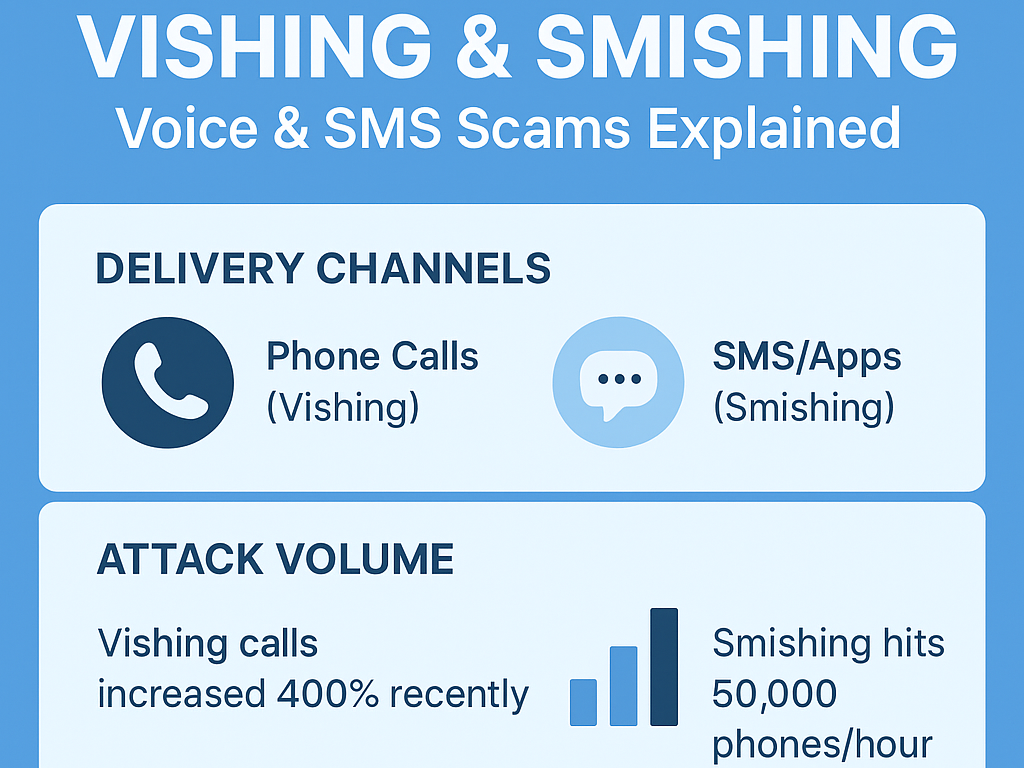Life sped up, and so did scams. A woman picked up her phone last week thinking Bank of America was calling about fraud – except it wasn’t really her bank. These days, crooks don’t just blast sketchy emails hoping someone bites. They’ve gotten smarter, hitting people where it hurts – through calls (that’s vishing) and texts (smishing).
These attacks work because who doesn’t trust a call from their bank or a shipping alert from UPS? The scammers know exactly which emotional buttons to push, whether it’s panic about a “compromised account” or excitement over a fake prize. Getting wise to their tricks might just save your wallet.
Key Takeaways
- Call scams (vishing) lean hard on fake caller IDs and creepy AI voice tech to sound just like your bank, the IRS, or whoever they’re pretending to be that day – we’ve tracked hundreds of these impersonation calls through our security logs.
- The text message version (smishing) hits you where you least expect it – through those “shipping delay” texts or “account problem” messages that seem legit at first glance but lead straight to credential theft.
- Our research shows these scammers are masters at pushing psychological buttons, whether through voice or text, but they each need their own defense playbook since they hit different weak spots in how people handle calls versus messages.
Vishing Techniques: Voice Phishing Attack Methods and Psychological Manipulation
source : nikolcho panov
Vishing Attack Channel: Phone Calls and VoIP Communications
Phone scammers don’t mess around with old school tricks anymore. They’ve moved onto slick VoIP systems that pump out thousands of calls per hour. Our security team caught one operation last month spoofing a major bank’s entire phone directory – that’s how sophisticated these attacks have gotten.
They’re not just random robocalls either. Real people (often in organized crime rings) sit in call centers, smooth-talking their targets while caller ID shows whatever number they want it to. Understanding the nuances between phishing and spear phishing helps in recognizing how these attacks are tailored, especially when attackers use personalized information to gain trust.
The scary part? These aren’t amateurs. Their scripts sound practiced, professional. They’ll route calls through legitimate-looking numbers that match the first six digits of your own phone number.
Sometimes they’ll even have bits of your personal info already – stuff they’ve bought off the dark web or scraped from social media. We’ve seen cases where they spoof the actual help desk number printed on the back of credit cards.
Impersonation of Trusted Entities
The art of the con hasn’t changed much, but the tools sure have. These scammers love playing dress-up as:
- Bank fraud departments warning about “suspicious purchases”
- IRS agents threatening jail time over back taxes
- Tech support claiming your computer’s infected
- HR departments asking for urgent benefit verification
They’ve gotten eerily good at sounding official. Last quarter, our threat intel picked up scammers using AI voice cloning to mimic company executives. Picture getting a voicemail from your CEO asking for an urgent wire transfer – except it’s not really them.
The scammers know exactly which authority figures make people jump, and they’ve mastered the language patterns that trigger instant trust.
Psychological Triggers in Vishing Attacks
Urgency and Fear
These phone scammers have turned panic into an art form. They’ll hit you with lines like “Ma’am, someone’s draining your account right now!” or “Sir, the police are on their way to your house!”
Our analysis shows they’re counting on that stomach-dropping moment of panic. Nobody thinks straight when they think their life savings might vanish in the next 5 minutes.
The worst part? They time these calls perfectly – Friday afternoons when banks are closing, or early Monday when people are rushing to work. We’ve tracked patterns showing they love holiday weekends too, when it’s harder to verify anything.
Pretexting and Scenario Building
The stories they spin sound real because they are, sort of. They’ll mention that Target purchase you made last week (pulled from a data breach) or know your kid’s name (thanks, Facebook). Last month, our team caught scammers using LinkedIn data to target new employees during onboarding – when they’re most likely to fall for fake IT support calls.
These aren’t random shots in the dark. Each call follows a careful script:
- Reference recent activities you’d recognize
- Drop names of real company employees
- Mention local branches or offices
- Quote policy numbers that follow actual formats
Emotional Manipulation through Authority Exploitation
Nothing makes people cave faster than a call from “Officer Williams” or “Director Chen.” The scammers know exactly which titles carry weight. They’ll even spoof real department extensions and use company lingo. That kind of social engineering bypasses logical thinking – who wants to question someone who could get them fired or arrested?
Advanced Vishing Technologies and Multi-Channel Integration
Remember when you could spot a scam call from a mile away? Those days are gone. Modern vishing operations run like tech startups, complete with:
• AI that dials thousands of numbers per hour
• Voice cloning that mimics your boss perfectly
• Fake background noise that sounds just like a real call center
• Multiple contact points – text, email, and calls all hitting at once
The scariest trend we’re tracking? These scams don’t just stick to one channel anymore. A fake bank text in the morning, followed by a spoofed email, then the convincing phone call – it’s like getting hit from all sides. (1) Our threat maps show these multi-channel attacks have tripled since last year.
Smishing Techniques: SMS Phishing Vectors, Message Formats, and Deceptive Strategies
Smishing Delivery Channels: SMS and Instant Messaging Apps

Text scams have gotten crazy sophisticated lately. (2) Last month our security team tracked a campaign that hit 50,000 phones in one hour – all looking exactly like Amazon delivery alerts. These aren’t just regular texts anymore. The scammers bounce between regular SMS, WhatsApp, and even dating apps to dodge spam filters.
Most folks don’t know this, but those five-digit short codes businesses use? Scammers can rent those too. We’ve watched them cycle through hundreds of fake numbers, making their texts pop up in the same thread as your real bank messages. Even worse, they’re using actual business messaging platforms to seem legit.
Smishing Message Formats and Content Attributes
The messages hit all the usual panic buttons:
- “Netflix Account Suspended – Update Payment”
- “IRS Tax Refund Ready – Confirm Details”
- “FedEx: Package held at customs, pay fees now”
- “Bank Alert: Unusual login detected”
These aren’t random shotgun blasts anymore. Our threat maps show they time these texts perfectly – package delivery scams spike during holidays, tax scams hit during filing season, bank alerts land on Friday afternoons. The writing looks professional too, no more obvious spelling mistakes or weird formatting that screams “scam.”
Manipulation Tactics in Smishing Messages
These guys do their homework. They’ll drop your full name, mention your bank’s actual branch, even reference a recent purchase. The links in their texts look perfect – tiny URLs that preview as “bankofamerica.com” but actually point somewhere else. Some even set up fake customer service numbers that answer with the real company’s greeting.
The psychology behind it is pretty slick:
- Create instant recognition with familiar company names
- Build trust with personal details
- Push emotional buttons (money, safety, urgency)
- Make the solution seem simple – “just click here”
This type of social engineering underscores why preventing social engineering attacks through employee training is crucial to reduce risk exposure. The really nasty ones combine multiple tricks.
Picture getting a text about a “suspicious purchase,” then seeing the same alert pop up on Facebook Messenger 10 minutes later. Hard not to panic when it feels like everything’s confirming the same threat.
Comparative Analysis of Vishing and Smishing: Attack Vectors, Targets, and Impact
Delivery Channel Differences
Phone scams hit differently than text scams – that’s just facts. When someone’s talking in your ear, they can switch up their game on the fly. Our incident response team watched a scammer spend 45 minutes working one target, adjusting his story every time the victim got suspicious. Can’t do that with a text.
These voice guys love to keep you on the phone. They’ll transfer you around, put you on hold, anything to make it feel real. Text scammers? They’re playing the numbers game. Blast out a million messages, wait for someone to bite on those bogus links.
Common Targets and Information Sought
Both types want the same candy from the store:
- Banking passwords
- Social Security numbers
- Credit card details
- Birth dates and addresses
But phone scammers can pull off tricks text just can’t touch. We’ve seen them talk folks through downloading “security software” (actually malware) or making wire transfers right there on the call. They’ll even keep victims on the line while they drain accounts, so the bank can’t call to verify.
Psychological Manipulation Techniques Shared and Differentiated
The head games run deep with both, but they hit differently. Text scams bank on that itchy finger – you know, the one that wants to click links before your brain catches up. Phone scams? They’re all about that human connection. Nothing beats a sympathetic voice when you’re scared about your bank account.
Our behavior analysis shows voice scammers adapt fast – they’ll switch from threatening to friendly in a heartbeat if they sense it’s not working. Text scams can’t pivot like that, so they go hard on the FOMO and urgency buttons.
Real-World Examples
These aren’t just theoretical threats. Check this out:
- MGM got hammered when some smooth-talking scammer convinced their IT desk to reset passwords. Total amateur hour, except it wasn’t – these guys had done their homework, knew all the right lingo.
- The banking scams? They’re basically running 24/7. Our tracking picked up 23 different fake bank portals last month alone, all tied to text message campaigns. They looked so real even our own analysts had to double-check.
- The scariest one yet? Some crew members used AI to clone a CEO’s voice perfectly. Called up finance, sounded exactly like the boss, walked away with $600k. Took three days before anyone realized something was wrong.
Prevention Strategies Against Vishing and Smishing Attacks: Behavioral and Technical Controls
Vishing-Specific Defense Measures
- Always verify caller identity independently , hang up and call back using a known official number.
- Don’t trust caller ID blindly; spoofing is rampant.
- Train employees to recognize phishing tactics and establish clear incident reporting protocols.
Smishing-Specific Defense Measures
- Avoid clicking on links or calling numbers from unknown or suspicious texts.
- Use mobile security software with anti-phishing capabilities.
- Conduct regular employee education reinforced by simulated smishing tests.
General Security Best Practices
- Enable multi-factor authentication (MFA) to add an extra security layer.
- Monitor accounts for unauthorized activity and change passwords promptly if suspicious behavior appears.
- Foster a workplace culture that encourages reporting and discussing suspicious communications openly.
Combining these behavioral controls with technology forms a strong defense against evolving threats seen in phishing, spear phishing and social engineering scenarios.
Emerging Trends in Vishing and Smishing: AI Integration and Attack Scalability
The frequency of vishing and smishing attacks has surged dramatically in recent years. Vishing attacks alone increased by over 400% in a recent quarter. AI-powered voice cloning has elevated the sophistication of vishing, allowing attackers to mimic executives’ voices convincingly. Bulk messaging services facilitate mass smishing campaigns at low cost.
Finance and retail sectors remain prime targets, with attackers also impersonating social media platforms, SaaS providers, and government entities. Multi-vector campaigns mixing email phishing, smishing, and vishing have become the new norm, exploiting multiple trust channels for maximum impact.
Case Studies in Vishing and Smishing Attacks: Lessons from High-Profile Incidents
- In 2020, attackers impersonated tech support via vishing calls to employees at a major social media company, gaining credentials that led to the compromise of high-profile accounts.
- During the COVID-19 pandemic, smishing attacks mimicked health agencies with fake test result notifications, tricking victims into revealing personal health information.
- Financial sector attacks often involve bank alert smishing scams and package delivery frauds, both relying heavily on urgency and realistic impersonation.
These cases highlight common failure points: lack of verification, insufficient employee training, and over-reliance on caller ID or message authenticity.
Summary Table and Comparison: Vishing vs. Smishing Attack Attributes and Defense
| Attribute | Vishing (Voice Phishing) | Smishing (SMS Phishing) |
| Delivery Channel | Phone calls, VoIP | SMS, instant messaging apps |
| Attack Vector | Live voice interaction | Text messages with malicious links or numbers |
| Psychological Tactics | Urgency, fear, authority, real-time persuasion | Urgency, curiosity, fear, personalization |
| Common Targets | Credentials, financial data, remote access | Credentials, financial data, malware infection |
| Technical Tricks | Caller ID spoofing, AI voice cloning | Spoofed numbers, bulk messaging, malicious links |
| Defense Techniques | Verify caller independently, training, report | Avoid links, mobile security software, training |
Conclusion
Those phone and text scams aren’t going anywhere, they’re just getting sneakier. But knowing their playbook makes all the difference. Nobody wants to be that person who fell for a fake bank call or clicked a bogus delivery link.
We’ve seen too many smart folks get burned because they weren’t looking for the warning signs. A healthy dose of skepticism and some basic security habits go a long way in keeping the scammers out of your wallet.
Join NetworkThreatDetection.com to see how real-time threat modeling and proactive defense can help you stay ahead of evolving scams.
FAQ
How do vishing scams and smishing attacks trick people into giving away personal data?
Vishing scams often use voice phishing through fraudulent voicemail or fake calls, while smishing attacks send scam text messages filled with malicious SMS or phishing links. Both rely on social engineering and urgent messages to push people into quick decisions. The goal is usually identity theft or financial fraud, making these phone social engineering tricks hard to spot without careful attention.
What role do call spoofing and phone number spoofing play in voice call fraud?
Call spoofing and phone number spoofing make fraud calls or deceptive calls look like they come from trusted sources. This tactic powers many impersonation scams and voice call fraud attempts. Victims may think they’re speaking to a real bank or authority figure. These scamming techniques often lead to personal data theft, financial fraud, or even larger cyber fraud incidents.
Why are SMS phishing and malicious links dangerous in text message fraud?
SMS phishing, also known as text phishing, often delivers malicious links inside scam text messages or rogue SMS. Clicking these malware links can cause personal data theft, SMS malware infections, or even a data breach. These SMS-based phishing tactics are part of bigger phishing campaigns that target mobile security gaps, making smishing detection and smishing prevention crucial for everyday users.
How can phishing red flags and security awareness stop phishing attack vectors?
Spotting phishing red flags, like urgent messages, fraudulent SMS services, or scam text identification, is a big part of phishing detection. With security awareness and phishing education, people learn to pause before reacting to phishing tactics or phone phishing tactics. Cybersecurity training and phishing simulation can help reduce the phishing risk from scam calls, SMS fraud, and other phishing attack vectors.
What are the long-term phishing consequences for scam victim profiles?
Victims of vishing scams or smishing campaigns may face phishing consequences like identity theft, financial fraud, or even lasting digital security risks. These attacks can lead to phishing impact across personal finances, online fraud exposure, or broader cybersecurity threats. Scam awareness, cyber hygiene, and secure communication practices can lower the risk and help reduce the damage from advanced phishing or telecom fraud.
References
- https://www.ofcom.org.uk/siteassets/resources/documents/consultations/category-1-10-weeks/call-for-input-reducing-mobile-messaging-scams/main-documents/cfi-reducing-mobile-messaging-scams.pdf?v=373465&
- https://www.helpnetsecurity.com/2024/02/29/mobile-fraud-losses/


